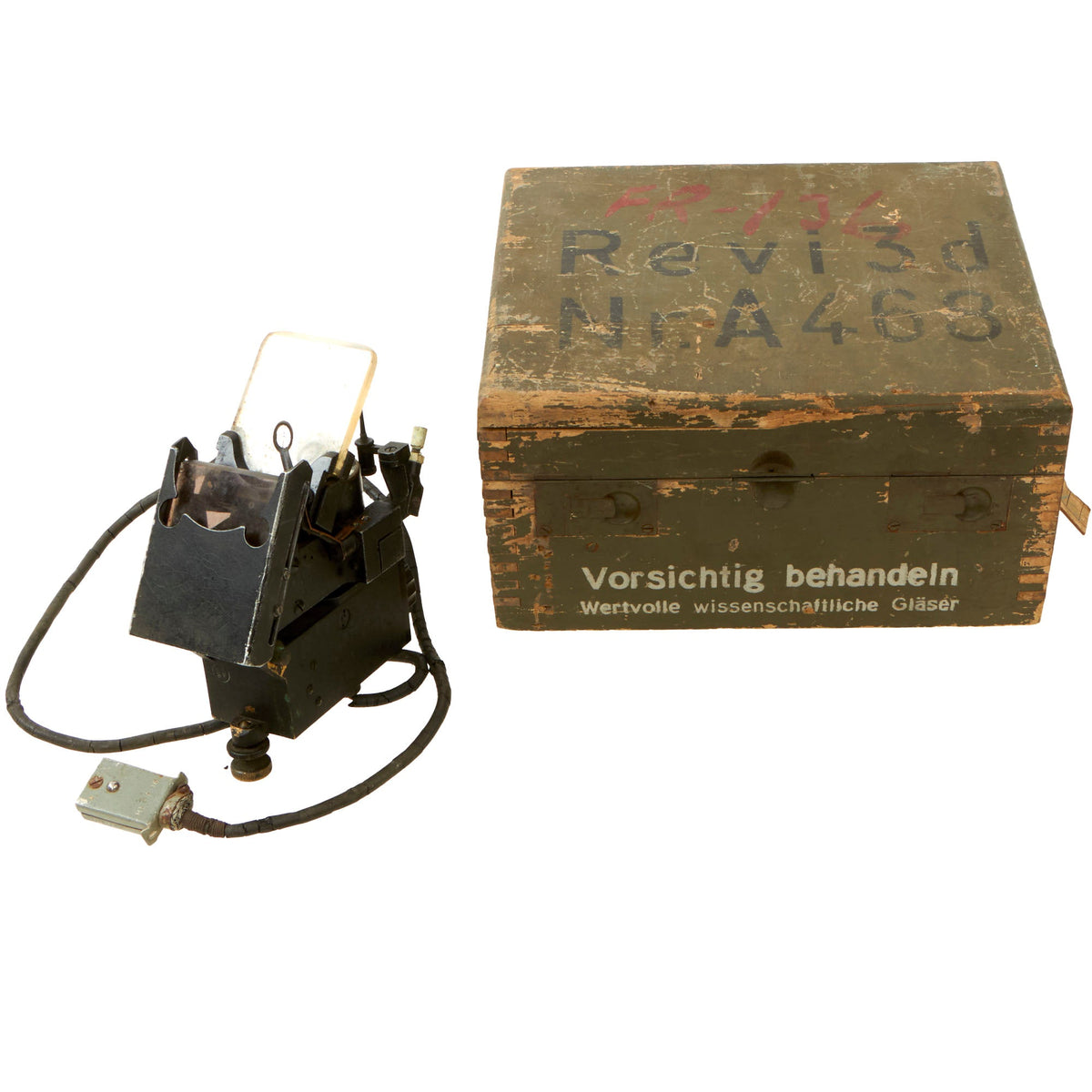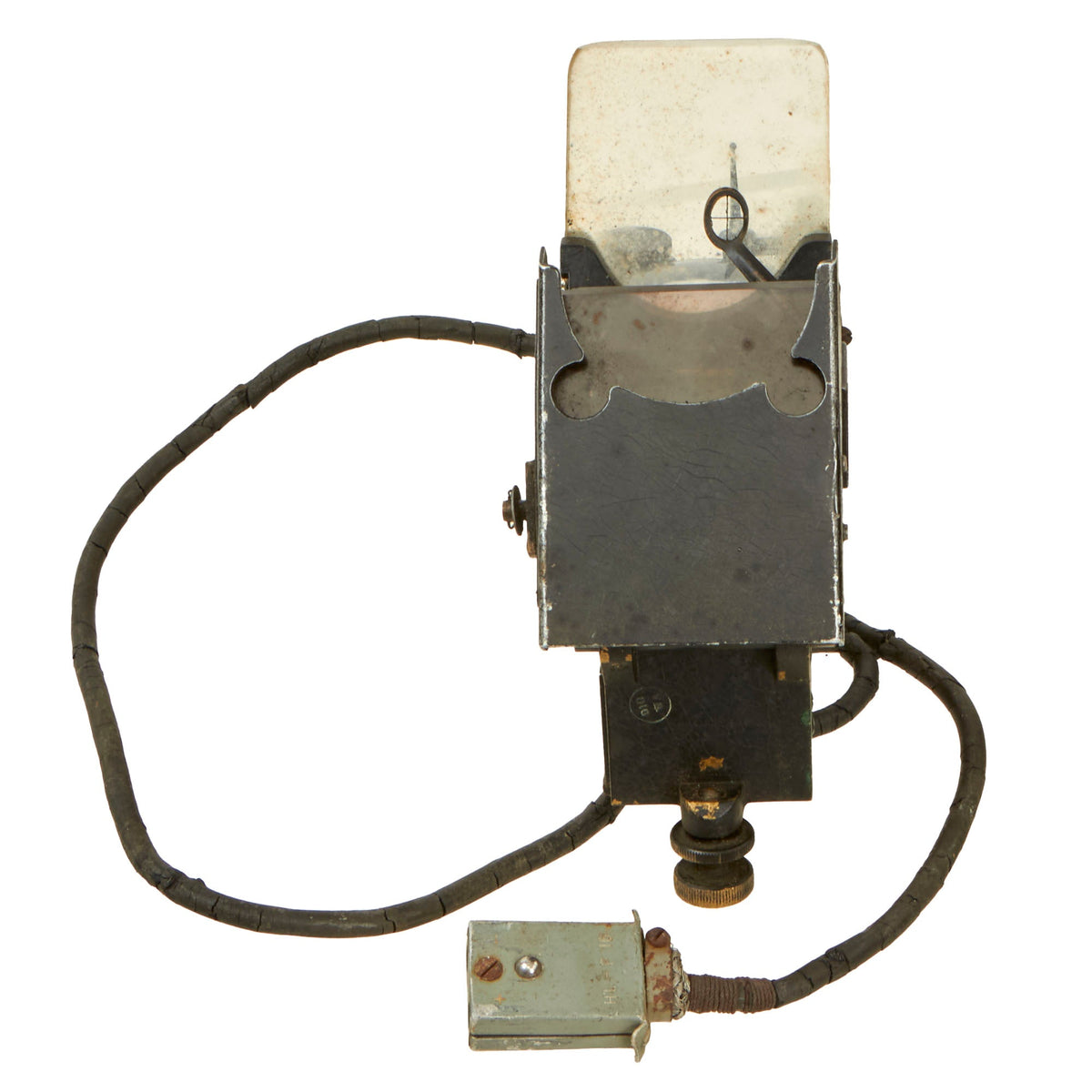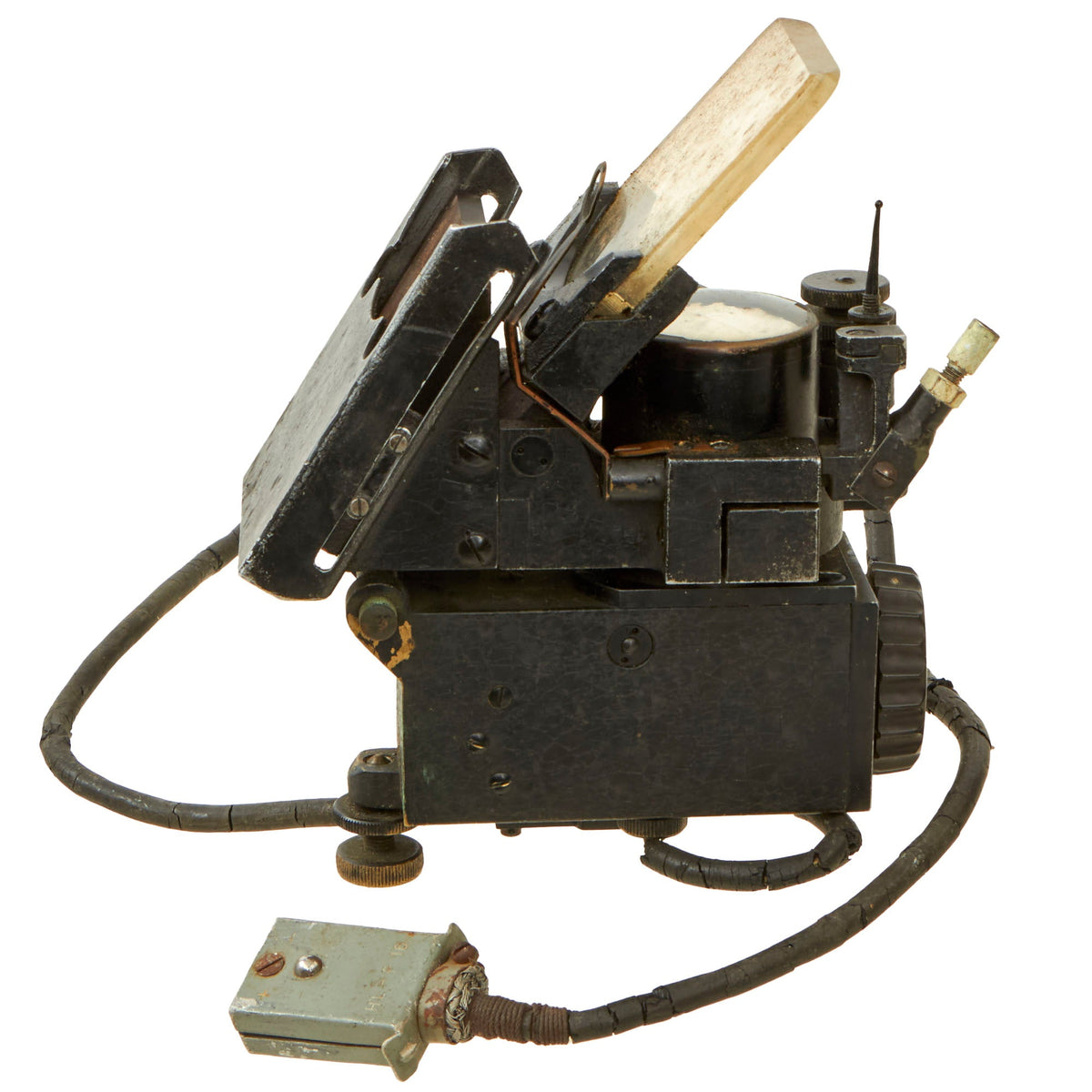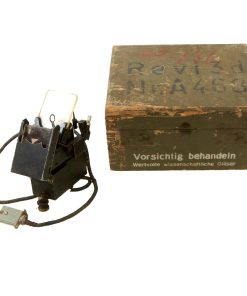Original German WWII Extremely Scarce Luftwaffe REVI 3d A 722 Gunsight in Original Transit Crate with Mounting Brackets – As Used in Messerschmitt Bf 109 Original Items
$ 4.495,00 $ 1.123,75
Original Item. Only One Available. The Messerschmitt Bf 109 is a German World War II fighter aircraft that was, along with the Focke-Wulf Fw 190, the backbone of the Luftwaffe’s fighter force. The Bf 109 first saw operational service in 1937 during the Spanish Civil War. It was still in service at the end of World War II in 1945. It was one of the most advanced fighters when it first appeared, with an all-metal monocoque construction, a closed canopy, and retractable landing gear. A liquid-cooled, inverted-V12 aero engine powered it. It was called the Me 109 by Allied aircrew and some German aces, even though this was not the official German designation.
This is an extremely scarce gunsight, REVI 3d, for use in the ME-109 aircraft, the backbone of the Luftwaffe’s fighter force. The sight is in its original transit crate, which measures 11 ¼” x 9 ⅜” x 5 ¾”. The code FR-136 has been painted in red on the top of the crate, and written in pencil on the interior. This was likely an inventory number. The top of the crate reads:
Revi 3d
Nr. A468
The front of the crate reads:
Vorsichtig behandeln
Wertvolle wissenschaftliche Gläser
Handle with Care
Valuable Scientific Glasses
The crate has a handle on the right side for carrying. The crate retains roughly 90% of its original paint job. The two latches still work to secure the crate shut. On the interior, there is still remnants of the original data label on the lid.
The gunsight fits snug into its spot in the case, with the small data plate on the side reading Revi 3d A722. This plate is on hinges and is the door for the bulb, which is still intact inside. The finish on the gunsight itself shows heavy cracking from age. The original electrical cord is intact but very rough, with the HL-P 16 plug still intact at the end. The end connected to the sight is very rough but still connected. The box also contains the small wrench which is kept in its corner by a small metal bracket. The original brackets for the sight are also in the box.
The sight itself measures 7″ x 6 ½” x 2 ¼” and appears to retain all original parts. Despite the cracking in the finish it is in great shape and will be a phenomenal addition and perhaps even the centerpiece of any WWII Luftwaffe collection. Comes ready for further research and display.
The Bf 109, designed by Messerschmidt and often called the ME 109, was one of the two main fighters used by the Luftwaffe during WWII, and it went through many revisions during the war. The final production version of the Bf 109 was the K series or Kurfürst (Elector), introduced in late 1944, powered by the DB 605D engine with up to 2,000 PS (1,471 kW; 1,973 hp). Though externally akin to the late production Bf 109G series, a large number of internal changes and aerodynamic improvements were incorporated that improved its effectiveness and remedied flaws, keeping it competitive with the latest Allied and Soviet fighters. The Bf 109’s outstanding rate of climb was superior to many Allied adversaries including the P-51D Mustang, Spitfire Mk. XIV and Hawker Tempest Mk. V. Introduced later in the war, there were approximately 1,700 of the Bf 109K-4 variant produced between August 1944 until March 1945, when production ceased.
The Bf 109 first saw operational service during the Spanish Civil War (1939) and was still in service at the dawn of the jet age at the end of World War II (1945). It was one of the most advanced fighters of the era, including such features as all-metal monocoque construction, a closed canopy, and retractable landing gear. It was powered by a liquid-cooled, inverted-V12 aero engine. From the end of 1941, the Bf 109 was steadily being supplemented by the superior Focke-Wulf Fw 190.
It was commonly called the Me 109 most often by Allied aircrew and even amongst the German aces themselves even though this was not the official German designation. The “Bf 109” designation was issued by the German ministry of aviation and represents the developing company Bayerische Flugzeugwerke and is a rather arbitrary figure.
It was designed by Willy Messerschmitt (hence Me 109) and Robert Lusser, who worked at Bayerische Flugzeugwerke, during the early to mid-1930s.
Originally conceived as an interceptor, later models were developed to fulfill multiple tasks, serving as bomber escort, fighter-bomber, day-, night-, all-weather fighter, ground-attack aircraft, and as reconnaissance aircraft. It was supplied to and operated by several states during World War II, and served with several countries for many years after the war. The Bf 109 was the most produced fighter aircraft in history, with a total of 33,984 airframes produced from 1936 up to April 1945.
The Bf 109 was flown by the three top-scoring German fighter aces of World War II, who claimed 928 victories among them while flying with Jagdgeschwader 52, mainly on the Eastern Front. The highest scoring fighter ace of all time, Erich Hartmann, flew the Bf 109 and was credited with 352 aerial victories. The aircraft was also flown by Hans-Joachim Marseille, the highest scoring German ace in the North African Campaign who achieved 158 aerial victories. It was also flown by several other aces from Germany’s allies, notably Finn Ilmari Juutilainen, the highest scoring non-German ace on the type, and pilots from Italy, Romania, Croatia, Bulgaria and Hungary. Through constant development, the Bf 109 remained competitive with the latest Allied fighter aircraft until the end of the war.
Fast Shipping with Professional Packaging
Thanks to our longstanding association with UPS FedEx DHL, and other major international carriers, we are able to provide a range of shipping options. Our warehouse staff is expertly trained and will wrap your products according to our exact and precise specifications. Prior to shipping, your goods will be thoroughly examined and securely secured. We ship to thousands clients each day across multiple countries. This shows how we're dedicated to be the largest retailer on the internet. Warehouses and distribution centres can be located throughout Europe as well as the USA.
Note: Orders with more than one item will be assigned a processing date depending on the item.
Before shipping before shipping, we'll conduct a thorough inspection of the items you have ordered. Today, the majority of orders will be delivered within 48 hours. The delivery time will be between 3-7 days.
Returns
The stock is dynamic and we cannot completely manage it because multiple stakeholders are involved, including our factory and warehouse. So the actual stock may alter at any time. It's possible that you may not receive your order once the order has been made.
Our policy is valid for a period of 30 days. If you don't receive the product within 30 days, we are not able to issue a refund or an exchange.
You can only return an item if it is unused and in the same state as the day you received it. You must have the item in its original packaging.
Related products
Uncategorized
Uncategorized
Uncategorized
Uncategorized
Uncategorized
Uncategorized
Armored Burgonet Helmet & Polearm from Scottish Castle Leith Hall Circa 1700 Original Items
Uncategorized
Uncategorized
Uncategorized
Uncategorized
Uncategorized
Uncategorized
Band of Brothers ORIGINAL GERMAN WWII Le. F.H. 18 10.5cm ARTILLERY PIECE Original Items
Uncategorized
Armoured Fighting Vehicles of the World: AFVs of World War One (Hardcover Book) New Made Items
Uncategorized
Uncategorized
Uncategorized
Uncategorized












































































